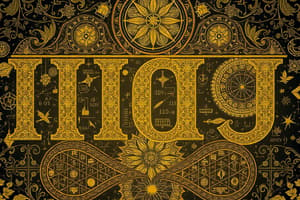Podcast
Questions and Answers
How many digits does the base 10 (decimal) system have?
How many digits does the base 10 (decimal) system have?
- 8
- 6
- 10 (correct)
- 12
What is the base value of the binary number system?
What is the base value of the binary number system?
- 5
- 8
- 2 (correct)
- 16
Why is the base 10 system commonly used in everyday life and mathematics?
Why is the base 10 system commonly used in everyday life and mathematics?
- Because it is used primarily in computer technology
- Due to its simplicity and familiarity (correct)
- Due to its association with octal numbers
- Because it uses binary digits
What is each digit called in the binary number system?
What is each digit called in the binary number system?
Which number system uses eight digits from 0 to 7?
Which number system uses eight digits from 0 to 7?
Why is the binary number system primarily used in computers?
Why is the binary number system primarily used in computers?
Why was the octal system historically used for mathematical calculations involving large numbers?
Why was the octal system historically used for mathematical calculations involving large numbers?
How is an octal number converted to decimal?
How is an octal number converted to decimal?
What makes the hexadecimal number system commonly used in computer technology?
What makes the hexadecimal number system commonly used in computer technology?
Why are hexadecimal numbers often used in computer graphics?
Why are hexadecimal numbers often used in computer graphics?
In what field is the binary system primarily used?
In what field is the binary system primarily used?
What is the significance of understanding number systems across various fields?
What is the significance of understanding number systems across various fields?
Flashcards are hidden until you start studying
Study Notes
Introduction
Number systems have been used since ancient times to represent numbers, perform arithmetic operations, and solve mathematical problems. They play a fundamental role in mathematics, science, engineering, economics, and many other fields. In this article, we will explore different number systems and their applications.
Base 10 Number System
The base 10, also known as decimal system, is the most commonly used number system in everyday life and mathematics. It has ten digits from 0 to 9, allowing us to represent any whole number by using these digits. For example, the number 764 can be written as 7 hundreds + 6 tens + 4 units. The base 10 is used because humans have ten fingers, which were originally used to count objects. This makes it intuitive and convenient for performing calculations.
Binary Number System
Binary is another important base system used primarily in computer technology. The binary system uses two digits, which are either 0 or 1. Each digit is called a bit (binary digit). The binary system has the base value of 2 and is used to represent numbers and data in computers because electronic circuits can only handle two states: on or off, which correspond to the binary digits '0' and '1' respectively. For example, the decimal number 8 can be represented in binary as 1000.
Octal Number System
The octal number system uses eight digits from 0 to 7. It was historically used for mathematical calculations involving large numbers due to its compactness when compared to using base 10. In the octal system, each group of three digits represents one digit in base ten. An octal number is written with just enough leading zeros to form groups of threes. The octal number 711 can be converted to decimal by writing out the threes place and then adding up the values: 78 + 18 + 1*8 = 56.
Hexadecimal Number System
The hexadecimal number system, also known as base 16, is commonly used in computer technology due to its compactness and ease of use. It uses ten digits from 0 to 9, and six special symbols A, B, C, D, E, and F, which represent the values 10 to 15. Hexadecimal numbers are often used to represent colors in computer graphics and to describe the memory content of computer systems. For example, the hexadecimal number FF0000 represents the color red.
Applications of Number Systems
Number systems have numerous applications in various fields. For instance, the binary system is used in digital electronics and computer programming, while the octal and hexadecimal systems are used in computer science and programming to represent large numbers compactly. The base 10 system is used in everyday life for calculations and in the decimal system for accounting and measuring.
In conclusion, number systems are essential for representing and manipulating numbers in various fields. Understanding these systems and their applications can greatly enhance one's ability to perform mathematical calculations and solve complex problems.
Studying That Suits You
Use AI to generate personalized quizzes and flashcards to suit your learning preferences.





